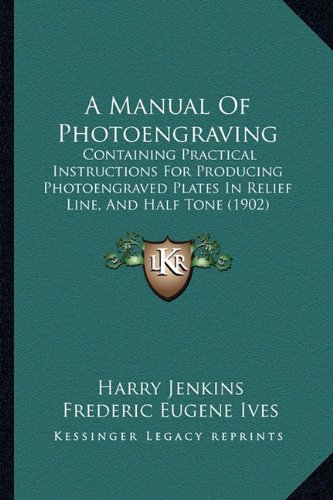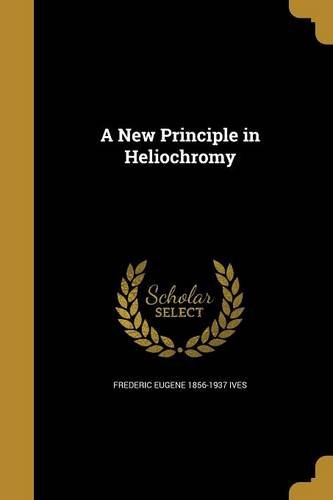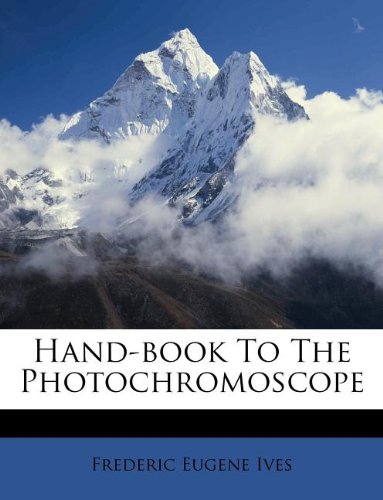Background
Frederic Eugene Ives was born on February 17, 1856, at Litchfield, Connecticut.



(This scarce antiquarian book is a facsimile reprint of th...)
This scarce antiquarian book is a facsimile reprint of the original. Due to its age, it may contain imperfections such as marks, notations, marginalia and flawed pages. Because we believe this work is culturally important, we have made it available as part of our commitment for protecting, preserving, and promoting the world's literature in affordable, high quality, modern editions that are true to the original work.
http://www.amazon.com/gp/product/1164537857/?tag=2022091-20

( This work has been selected by scholars as being cultur...)
This work has been selected by scholars as being culturally important, and is part of the knowledge base of civilization as we know it. This work was reproduced from the original artifact, and remains as true to the original work as possible. Therefore, you will see the original copyright references, library stamps (as most of these works have been housed in our most important libraries around the world), and other notations in the work. This work is in the public domain in the United States of America, and possibly other nations. Within the United States, you may freely copy and distribute this work, as no entity (individual or corporate) has a copyright on the body of the work. As a reproduction of a historical artifact, this work may contain missing or blurred pages, poor pictures, errant marks, etc. Scholars believe, and we concur, that this work is important enough to be preserved, reproduced, and made generally available to the public. We appreciate your support of the preservation process, and thank you for being an important part of keeping this knowledge alive and relevant.
http://www.amazon.com/gp/product/1363130919/?tag=2022091-20

(This is a reproduction of a book published before 1923. T...)
This is a reproduction of a book published before 1923. This book may have occasional imperfections such as missing or blurred pages, poor pictures, errant marks, etc. that were either part of the original artifact, or were introduced by the scanning process. We believe this work is culturally important, and despite the imperfections, have elected to bring it back into print as part of our continuing commitment to the preservation of printed works worldwide. We appreciate your understanding of the imperfections in the preservation process, and hope you enjoy this valuable book. ++++ The below data was compiled from various identification fields in the bibliographic record of this title. This data is provided as an additional tool in helping to ensure edition identification: ++++ Hand-book To The Photochromoscope Frederic Eugene Ives Simpkin, Marshall, Hamilton, Kent, 1894 Color photography
http://www.amazon.com/gp/product/117358871X/?tag=2022091-20
Frederic Eugene Ives was born on February 17, 1856, at Litchfield, Connecticut.
Frederic Ives left school before the age of 12 to find a job and earn a living after the early death of his father from pulmonary consumption.
Lacking any formal education, Ives moved to Ithaca, New York to become a printer's apprentice, and after two years redirected his efforts to photography. He became the official photographer for Cornell University at the age of 18 and headed the school's photographic laboratory from 1875 to 1878.
Around 1878, Ives turned his attentions exclusively to photographic experimentation. He researched various photomechanical techniques including halftone reproductions of objects through the use of cross-line screens that differed from the conventional pinhole process, but proved to be every bit as effective. He also experimented extensively with color photography and designed a beam-splitting camera that allowed a single lens to expose negatives through red, blue, and green filters. Black and white transparencies could then be viewed with a reflecting and filtering instrument that combined the colors into a single color image. The device, known as Kromskop, and its Kromograms were sold commercially, along with camera adapters that allowed photographers to take color photographs. This is believed to be the first American camera making tri-color separation negatives in one exposure. While certainly unique and innovative, the process was complicated and the equipment requirements proved too cumbersome and expensive, and soon simpler color photography techniques overtook the Kromskop's initial success.
Around 1879, he began an association with Philadelphia's Crosscup & West Engraving Company, which later commercially manufactured his halftone plates. Throughout the 1880s, Frederick Ives worked tirelessly to perfect his halftone techniques with the invention of a pinhole glass screen. He truly pioneered the three-color halftone method, which he referred to as indirect color photography, and demonstrated before enthusiastic audiences at Philadelphia's Franklin Institute.
One of Frederic Ives' proudest accomplishments was the invention of the photochromoscope in 1895. This technique allows images to be photographed through tricolor (red, green, and blue) optical screens in which these colors are then superimposed and blended to create a color photograph. In 1901, Ives opened the Ives Process Company of New York, which specialized in making these tricolor plates. Two years' later, he received a patent for a parallax stereogram, which could be applied to present the illusion of a three-dimensional image. However, to achieve this effect, the image had to be viewed from a specific vantage point or the image's 3-D qualities would be lost.
His last invention of note was Polychrome (1932), which was a simplified two-color process for conventional cameras. Frederick Ives died in Philadelphia on May 27, 1937.
Frederic Eugene Ives was one of the most fanous U. S. inventors. He is also known for his pioneering work in color and stereo photographic processes. Ives also invented the photochromoscope camera, which produced a three-color negative, and he did extensive work with color and stereoscopic photography simulating three-dimensional imagery, including several early 3-D motion picture shorts.
Frederic Ives was awarded the Franklin Institute's Elliott Cresson Medal in 1893, the Edward Longstreth Medal in 1903, and the John Scott Medal in 1887, 1890, 1904 and 1906. In 1912, he was awarded Rumford Prize.
( This work has been selected by scholars as being cultur...)
(This scarce antiquarian book is a facsimile reprint of th...)
(This is a reproduction of a book published before 1923. T...)
On June 14, 1879, Frederic Eugene Ives married Mary Elizabeth Olmstead and together they had two sons, Herbert Eugene Ives and Edwin Olmstead Ives.
Herbert Eugene Ives was a scientist and engineer who headed the development of facsimile and television systems at AT&T in the first half of the twentieth century.
